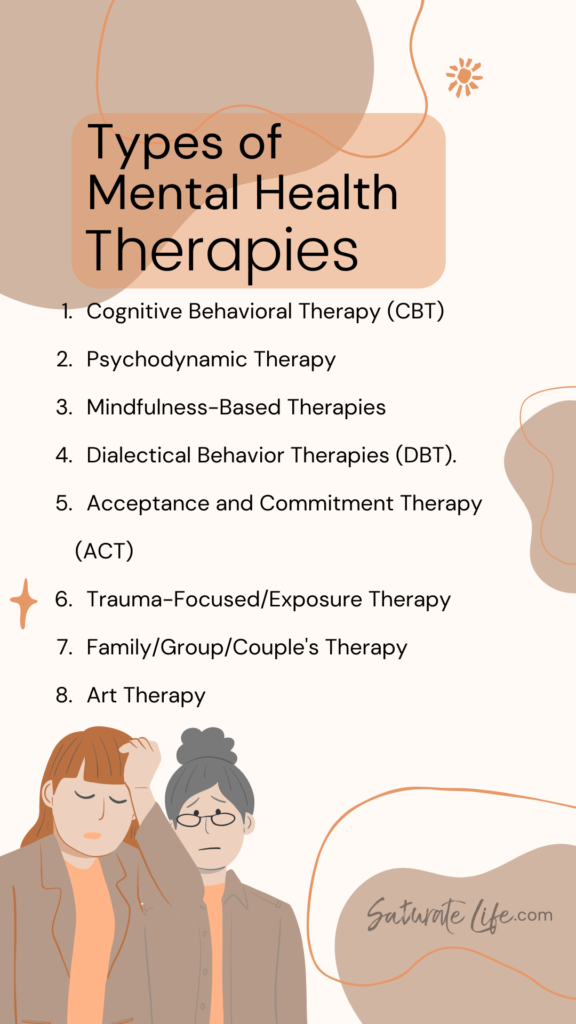Therapy comes in different kinds and forms. Therapy is personalized and indeed catered to the individual person seeking it out. Which you should if you need it. It’s a very valuable thing to make ends meet. I am not a therapist so listen to them and their thoughts on how to approach your Mental Health. Be open to different types of therapy as the therapist is the person who will decide what is the best form for you specifically.

1. Cognitive Behavioral Therapy (CBT)
CBT is a structured and goal-oriented therapy that focuses on identifying and challenging negative thought patterns (cognitions) and behaviors that contribute to emotional distress. Therapists help individuals recognize distortions in their thinking and develop healthier, more balanced ways of thinking. They also encourage clients to engage in behavioral experiments to test the validity of their beliefs. CBT is effective for various conditions, including depression, anxiety disorders, phobias, and obsessive-compulsive disorder. 2

2. Psychodynamic Therapy
Psychodynamic therapy is rooted in psychoanalytic principles, aiming to explore the unconscious influences on an individual’s thoughts and behaviors. Therapists help clients delve into past experiences, childhood relationships, and early memories to gain insight into their current emotional and psychological struggles. The therapeutic relationship and dynamics are often central to this therapy, and it can take time to uncover deeper insights. 3

3. Mindfulness-Based Therapies
Mindfulness-based therapies incorporate mindfulness practices, which involve paying attention to the present moment without judgment. These therapies, such as MBSR and MBCT, are effective for managing stress, anxiety, and depression. Clients learn to cultivate awareness of their thoughts, emotions, and bodily sensations, helping them respond to challenging situations more skillfully.

4. Dialectical Behavior Therapies (DBT)
DBT was initially developed for individuals with borderline personality disorder, but it has been found helpful for various conditions involving emotional dysregulation. DBT combines cognitive behavioral techniques with mindfulness and acceptance strategies. Clients learn skills to manage intense emotions, tolerate distress, improve interpersonal relationships, and regulate their behavior.4

5. Acceptance and Commitment Therapy (ACT)
ACT encourages clients to accept their thoughts and feelings, even if they are uncomfortable, and commit to actions aligned with their values. This therapy helps individuals break free from the struggle to control or avoid negative emotions, fostering psychological flexibility and resilience. 5

6. Trauma-Focused/Exposure Therapy
Therapies like Eye Movement Desensitization and Reprocessing (EMDR) and Trauma-Focused Cognitive Behavioral Therapy (TF-CBT) are designed to help individuals process and heal from traumatic experiences. Exposure therapy is often used to treat anxiety disorders by gradually exposing individuals to feared situations or stimuli in a controlled and safe manner to reduce their anxiety over time

7. Family/Group/Couple’s Therapy
Family therapy involves working with families to improve communication, resolve conflicts, and address issues that affect the entire family system. Group therapy involves a therapist leading a group of individuals with similar concerns. It provides a supportive environment for members to share their experiences, receive feedback, and learn from others. Couple’s therapy, also known as marital or relationship therapy, is a type of therapy aims to improve communication, resolve conflicts, and strengthen the relationship between couples.

8. Art Therapy
Art therapy involves using various forms of artistic expression, such as drawing, painting, and sculpting, to explore emotions, thoughts, and experiences. This creative process can help individuals communicate and process feelings that might be difficult to express verbally. 6
Don’t ever be afraid of different types of therapy and navigating a way through it. Be honest with a therapist if there is fear or apprehension. It’s okay.
Take care of yourself,
Rachel McG

- Macdonald G, Livingstone N, Hanratty J, et al. The effectiveness, acceptability and cost-effectiveness of psychosocial interventions for maltreated children and adolescents: an evidence synthesis. Southampton (UK): NIHR Journals Library; 2016 Sep. (Health Technology Assessment, No. 20.69.) Appendix 5, Types of interventions. Click here for a link.
- Nakao M, Shirotsuki K, Sugaya N. Cognitive-behavioral therapy for management of mental health and stress-related disorders: Recent advances in techniques and technologies. Biopsychosoc Med. 2021 Oct 3;15(1):16. doi: 10.1186/s13030-021-00219-w. PMID: 34602086; PMCID: PMC8489050. Click here for a link.
- Fonagy P. The effectiveness of psychodynamic psychotherapies: An update. World Psychiatry. 2015 Jun;14(2):137-50. doi: 10.1002/wps.20235. PMID: 26043322; PMCID: PMC4471961. Click here for a link
- Chapman AL. Dialectical behavior therapy: current indications and unique elements. Psychiatry (Edgmont). 2006 Sep;3(9):62-8. PMID: 20975829; PMCID: PMC2963469. Click here for a link
- Dindo L, Van Liew JR, Arch JJ. Acceptance and Commitment Therapy: A Transdiagnostic Behavioral Intervention for Mental Health and Medical Conditions. Neurotherapeutics. 2017 Jul;14(3):546-553. doi: 10.1007/s13311-017-0521-3. PMID: 28271287; PMCID: PMC5509623. Click here for a link.
- Hu J, Zhang J, Hu L, Yu H, Xu J. Art Therapy: A Complementary Treatment for Mental Disorders. Front Psychol. 2021 Aug 12;12:686005. doi: 10.3389/fpsyg.2021.686005. PMID: 34456801; PMCID: PMC8397377. Click here for a link.


